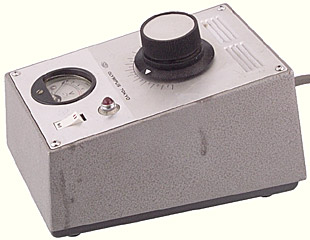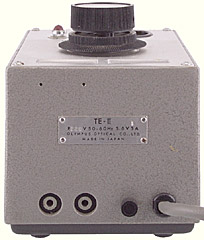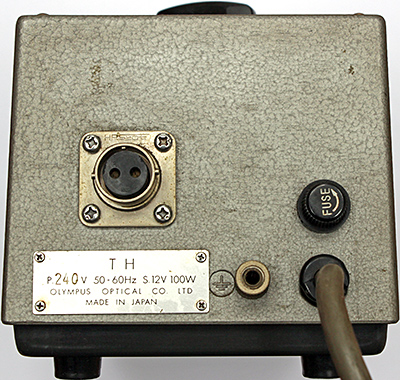Olympus OM system close-up and macro equipment
Transformers
The Epi-Illuminator and the Trans-Illuminator use a high-intensity, low-voltage tungsten bulb, which is powered from a transformer. The transformer has a voltage control knob and a power indicator light on the top surface, and an earth socket and a pair of 4 mm sockets for the 2 “banana” plugs from the Illuminator at the rear.
The bulbs in the Illuminators burn out quickly at maximum voltage, and the filament is quite fragile. To get maximum life from the bulbs, do not run them at more than 6 volts. Before switching on the transformer, make sure that the voltage is at minimum, and increase it slowly after switching on. Before switching off, turn the voltage slowly to minimum.
The maximum setting of the voltage control knob can be adjusted, to help prevent burning out the bulb.
- Adjust the brightness to your preferred maximum, either visually or by using the voltage scale.
- Press and hold down the flat collar surrounding the base of the knob.
- Turn the collar anti-clockwise as far as it will go.
- Release the collar.
If you cannot turn up the brightness as far as you want, then its maximum has probably been set as above. Press down the flat collar and turn it clockwise to allow the brightness to be increased
There were 3 models of transformer supplied with the Epi-Illuminator and the Trans-Illuminator, and each model was available in versions for different mains voltages.
TE-II Transformer
The oldest of the 3 models, introduced to the OM system in 1972 although it was available as a microscope accessory before then. The metallic body parts are finished in a “hammered” medium grey, similar to the grey parts of the Auto Bellows. On the top surface, there is a control knob and a circular, analogue meter reading from 0–12 volts (0–6 marked black, 6–12 marked in red). The markings on the scale around the control knob are all black, with no numbers. The top surface also carries an on-off switch and a red power indicator light. The 2 small holes at the top of the rear are for attaching a block onto which an LSG-II illuminator for stereo microscopes can be clamped. There are separate versions for 110 volts and for 220 volts.
 |
 |
| Olympus OM TE-II Transformer | Rear of Olympus OM TE-II Transformer |
| Input | 110 V 50–60 Hz | 220 V 50–60 Hz |
|---|---|---|
| Output | 6 V 5 A | 6 V 5 A |
| Mains lead | 1600 mm | 1600 mm |
| Microscope ref. | TE-2 | TE-2 |
| US catalog no. | n/a | |
| Introduced | 1972 | 1972 |
| Discontinued |
Versions
An older version, pre-dating the OM system, is finished in a smooth pale grey.
TF Transformer
The second model also has its metallic body parts finished in a “hammered” medium grey, similar to the grey parts of the Auto Bellows. This model does not have a volt meter. The scale around the control knob is part black (0–6 volts) and part red (above 6 volts). There are separate versions for 110, 120 and 220 volts.
| Input | 110 V 50–60 Hz | 120 V 50–60 Hz | 220 V 50–60 Hz |
|---|---|---|---|
| Output | 6 V 5 A | 6 V 5 A | 6 V 5 A |
| Mains lead | 1600 mm | 1600 mm | 1600 mm |
| Microscope ref. | TF | TF | TF |
| US catalog no. | n/a | ||
| Introduced | |||
| Discontinued |
Versions
There is another version of the TF transformer, with a rectangular 2-pin socket for use with the coaxial incident light fitting of an Olympus metallurgical microscope.
TGHM Transformer
The most recent model has its metallic body parts finished in a smooth pale cream. On the top surface there is an LED voltage readout. There are separate versions for 110/115 and 220/240 volts.
| Input voltage | 110/115 V, 50–60 Hz | 220/240 V, 50–60 Hz |
|---|---|---|
| Input current | 0.7/0.6 A | 0.35/0.30 A |
| Output | 6 V 30 W | 6 V 30 W |
| Fuse | 7 A Fast | 7 A Fast |
| Microscope ref. | TGHM | TGHM |
| US catalog no. | 104-139 | n/a |
| Introduced | ||
| Discontinued | 2003* | 2003* |
* Still available for stereo microscopes
Versions
There is also a TGH transformer, but this provides a 12 V 50 W output for the lamp housings in some reflected-light attachments for Olympus BH-2 microscopes, including the BH2-MLSH and BH2-ULSH80.
Transformers for microscopes
These transformers are not suitable for the Epi-Illuminator or the Trans-Illuminator.
TF Transformer
There is another version of the TF transformer, with a rectangular 2-pin socket for use with the coaxial incident light fitting of an Olympus metallurgical microscope.
TGH Transformer
This is similar to the TGHM transformer, but provides a 12 V 50 W output. The common version has a circular socket for the lamp housings in some reflected-light attachments for Olympus BH-2 microscopes, including the BH2-MLSH (which fits the BH2-MA and BH2-RLA) and the BH2-ULSH80. There is also an uncommon version with separate red and black sockets.
TH Transformer
This provides a 12 V 100 W output for the optional BH-LSH lamp housing for the Olympus BHA and BHB microscopes. It has a circular 2-pin socket, it is finished in a “hammered” medium grey, and it has a meter like the one in the TE-II. There were versions for 220 V and 240 V, and probably other voltages too.

Rear of Olympus TH Transformer
Send comments or questions to Alan Wood
![]()
Created 18th May 2001 — Updated 15th June 2020
Copyright © 2001–2020 Alan Wood